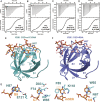Drosophila YBX1 homolog YPS promotes ovarian germ line stem cell development by preferentially recognizing 5-methylcytosine RNAs
- PMID: 32015133
- PMCID: PMC7035628
- DOI: 10.1073/pnas.1910862117
Drosophila YBX1 homolog YPS promotes ovarian germ line stem cell development by preferentially recognizing 5-methylcytosine RNAs
Abstract
5-Methylcytosine (m5C) is a RNA modification that exists in tRNAs and rRNAs and was recently found in mRNAs. Although it has been suggested to regulate diverse biological functions, whether m5C RNA modification influences adult stem cell development remains undetermined. In this study, we show that Ypsilon schachtel (YPS), a homolog of human Y box binding protein 1 (YBX1), promotes germ line stem cell (GSC) maintenance, proliferation, and differentiation in the Drosophila ovary by preferentially binding to m5C-containing RNAs. YPS is genetically demonstrated to function intrinsically for GSC maintenance, proliferation, and progeny differentiation in the Drosophila ovary, and human YBX1 can functionally replace YPS to support normal GSC development. Highly conserved cold-shock domains (CSDs) of YPS and YBX1 preferentially bind to m5C RNA in vitro. Moreover, YPS also preferentially binds to m5C-containing RNAs, including mRNAs, in germ cells. The crystal structure of the YBX1 CSD-RNA complex reveals that both hydrophobic stacking and hydrogen bonds are critical for m5C binding. Overexpression of RNA-binding-defective YPS and YBX1 proteins disrupts GSC development. Taken together, our findings show that m5C RNA modification plays an important role in adult stem cell development.
Keywords: GSC; RNA methylation; YBX; YPS; m5C.
Conflict of interest statement
The authors declare no competing interest.
Figures




Similar articles
-
Identification and developmental characterization of a novel Y-box protein from Drosophila melanogaster.Nucleic Acids Res. 1997 Dec 1;25(23):4764-70. doi: 10.1093/nar/25.23.4764. Nucleic Acids Res. 1997. PMID: 9365254 Free PMC article.
-
Aberrant downregulation of Y-box binding protein 1 expression impairs the cell cycle in an m5C-dependent manner in human granulosa cells from patients with primary ovarian insufficiency.Cell Mol Life Sci. 2025 May 21;82(1):206. doi: 10.1007/s00018-025-05709-6. Cell Mol Life Sci. 2025. PMID: 40397139 Free PMC article.
-
5-methylcytosine promotes pathogenesis of bladder cancer through stabilizing mRNAs.Nat Cell Biol. 2019 Aug;21(8):978-990. doi: 10.1038/s41556-019-0361-y. Epub 2019 Jul 29. Nat Cell Biol. 2019. PMID: 31358969
-
The Role of RNA m5C Modification in Central Nervous System Diseases.Discov Med. 2024 Aug;36(187):1555-1571. doi: 10.24976/Discov.Med.202436187.143. Discov Med. 2024. PMID: 39190372 Review.
-
Myc in stem cell behaviour: insights from Drosophila.Adv Exp Med Biol. 2013;786:269-85. doi: 10.1007/978-94-007-6621-1_15. Adv Exp Med Biol. 2013. PMID: 23696362 Review.
Cited by
-
mRNA m5C controls adipogenesis by promoting CDKN1A mRNA export and translation.RNA Biol. 2021 Nov 12;18(sup2):711-721. doi: 10.1080/15476286.2021.1980694. Epub 2021 Sep 27. RNA Biol. 2021. PMID: 34570675 Free PMC article.
-
YB1 participated in regulating mitochondrial activity through RNA replacement.Front Oncol. 2023 Mar 23;13:1145379. doi: 10.3389/fonc.2023.1145379. eCollection 2023. Front Oncol. 2023. PMID: 37035211 Free PMC article.
-
The epitranscriptome beyond m6A.Nat Rev Genet. 2021 Feb;22(2):119-131. doi: 10.1038/s41576-020-00295-8. Epub 2020 Nov 13. Nat Rev Genet. 2021. PMID: 33188361 Review.
-
Bioinformatics approaches for deciphering the epitranscriptome: Recent progress and emerging topics.Comput Struct Biotechnol J. 2020 Jun 13;18:1587-1604. doi: 10.1016/j.csbj.2020.06.010. eCollection 2020. Comput Struct Biotechnol J. 2020. PMID: 32670500 Free PMC article. Review.
-
The Role of RNA Modification in HIV-1 Infection.Int J Mol Sci. 2022 Jul 8;23(14):7571. doi: 10.3390/ijms23147571. Int J Mol Sci. 2022. PMID: 35886919 Free PMC article. Review.
References
-
- Dubin D. T., Stollar V., Methylation of Sindbis virus “26S” messenger RNA. Biochem. Biophys. Res. Commun. 66, 1373–1379 (1975). - PubMed
-
- Yang Y., et al. , RNA 5-methylcytosine facilitates the maternal-to-zygotic transition by preventing maternal mRNA decay. Mol. Cell. 75, 1188–1202.e11 (2019). - PubMed
-
- Chen X., et al. , 5-methylcytosine promotes pathogenesis of bladder cancer through stabilizing mRNAs. Nat. Cell Biol. 21, 978–990 (2019). - PubMed
Publication types
MeSH terms
Substances
Associated data
- Actions
- Actions
Grants and funding
LinkOut - more resources
Full Text Sources
Molecular Biology Databases
Research Materials

